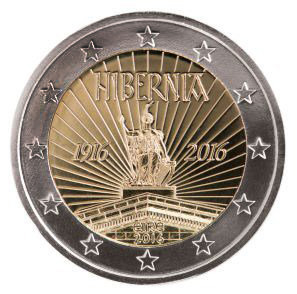 The Central Bank are poised to issue a total of 4.5 million coins including a new €2 coin to commemorate the ‘1916 Easter Rising’. Contrary to newspaper reports, this is not the first occasion that Ireland has issued commemorative currency into circulation.
The Central Bank are poised to issue a total of 4.5 million coins including a new €2 coin to commemorate the ‘1916 Easter Rising’. Contrary to newspaper reports, this is not the first occasion that Ireland has issued commemorative currency into circulation.
It is interesting to note that the Irish Central Bank issued 2,000,000 coins to commemorate the fiftieth anniversary of the Easter Rising in 1966. Unfortunately they were not popular with the Irish public and did not circulate widely; the Irish government actually put them into the pay packets of civil service in their efforts to distribute them.
It is reputed that the Irish Central Bank later, just some six years later, around 1971, melted down about 1,250,000 of same, with the advent of decimalisation. Many more are reckoned to have entered into the melting pot due to another popular ‘Irish Rising’, that being the rising of the price of silver to record heights in 1980/81.
Emmet Mullins, the designer of the new coinage, was chosen following a competition that saw 52 Irish and international designers submit proposals, based on ‘The Proclamation of the Irish Republic’.
The new coinage features a representation of the statue of Hibernia which presently sits, centre, on top of the General Post Office (GPO Ard-Oifig an Phoistis), the headquarters of the Irish Post Office. The name ‘Hibernia’ is the classical Latin name for the island of Ireland. The Roman historian Tacitus, in his book Agricola (c. 98 AD), possibly first used the name ‘Hibernia’, which is rarely used today with regard to Ireland. In 1642 the motto of the Irish Confederates, a Catholic-landlord administration that ruled much of Ireland until 1650 was: “Pro Deo, Rege et Patria, Hibernia Unanimis”, which when translated is ‘For God, King and Fatherland, Ireland is United’.
The GPO is one of Ireland’s most famous buildings and was the last of the great Georgian public buildings erected in Sackville Street (today named O’Connell Street) in Dublin. The building was opened for business on January 6th 1818, with the structure having been completed in the space of just three years for the sum of £50,000. (Faster and cheaper than we can provide houses for our Irish homeless today).
During the Easter Rising of 1916, the GPO served as the headquarters of most of the uprising’s leaders. It was destroyed by fire in the course of this rebellion and was not restored until the Irish Free State government, some years later, identified the task.
Interestingly, particularly from a Sinn Féin point of view, despite its fame as an iconic place of Irish freedom, ground rent for the GPO continued to be paid to British and American landlords; right up until the 1980’s.
The hand-rendered lettering featuring the centenary dates and the name ‘Hibernia’ are reportedly influenced by the Book of Kells, which according to the Central Bank, An Post and all Bank branches are expected to get into general circulation as soon as is possible.
Later this year other gold and silver proof coins designed by Welsh artist, engraver and graphic designer Michael Guilfoyle, also commemorating 1916, will be released for sale. Guilfoyle’s designs also feature the name ‘Hibernia’, along with an arrangement of other key words and phrases taken from the 1916 Proclamation.

Leave a Reply